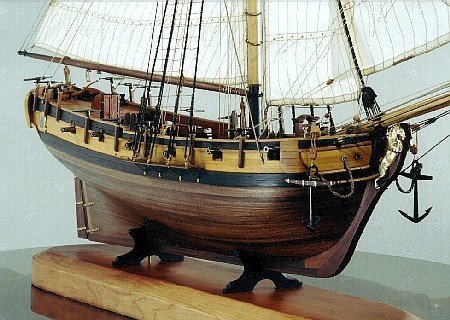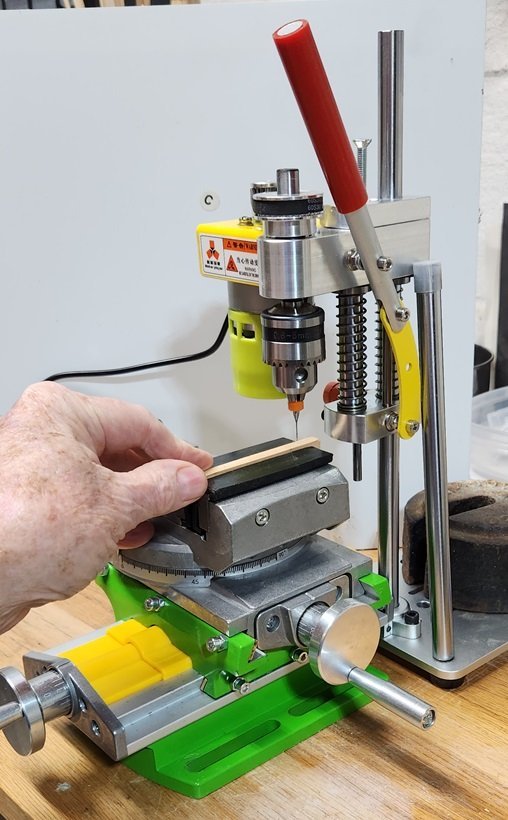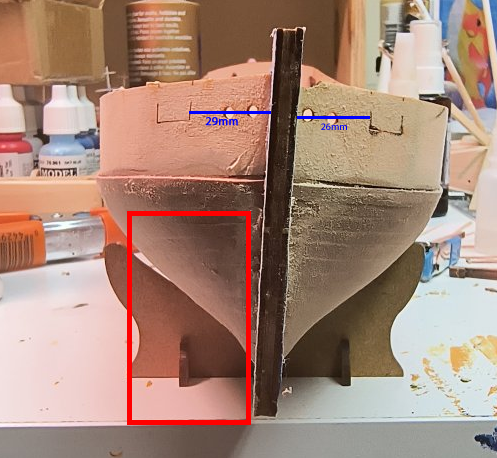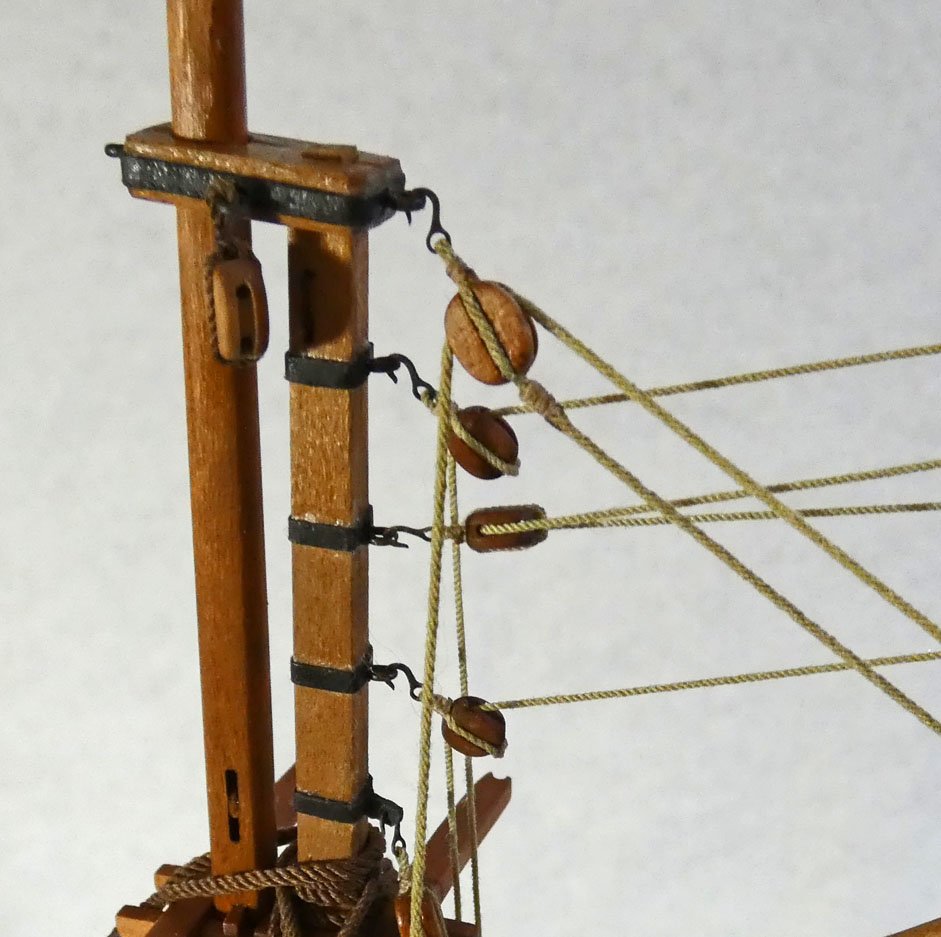-
Posts
3,152 -
Joined
-
Last visited
Content Type
Profiles
Forums
Gallery
Events
Everything posted by Gregory
-
Does anyone know what this rigging is called?
Gregory replied to RobMann79's topic in Masting, rigging and sails
I have never heard that explanation before. In this discussion: Question on use of crowsfeet on ship rigged vessels - Masting, rigging and sails - Model Ship World™ It is suggested that " ..Crowsfeet were designed to prevent the foot of the fore and main topsails from getting caught under the tops. " That is what I have always understood their purpose to be. This image from another discussion, shows how it was rigged. Here is another post that shows a little more detail of how it was rigged. https://modelshipworld.com/topic/2293-rattlesnake-by-jsgerson-finished-mamoli-164-using-robert-hunt’s-practicum/?do=findComment&comment=333009 -
When all is said and done, I would agree that this is the way to go.
- 53 replies
-
- Drill Press
- Milling
-
(and 1 more)
Tagged with:
-
I think you have a very valid point. For me it’s more of the idea of having it if I need it. I really don’t use it very often. If you can use it for some light milling it’s another plus.
- 53 replies
-
- Drill Press
- Milling
-
(and 1 more)
Tagged with:
-
There is a keyless chuck for the MF70 I have found it to be convenient for the tools it supports. 1/64 - 1/8 Shanks.
- 53 replies
-
- Drill Press
- Milling
-
(and 1 more)
Tagged with:
-
I have the Proxxon MF70, while a great little mill, it is not very efficient as a drill press. I reviewed a press I got on Amazon, which has turned out to be very satisfactory. I cover a lot of concerns and questions in my review. Mini Bench Drill Press - Modeling tools and Workshop Equipment - Model Ship World™ There was a lot of discussion about this and that, and in the end the the major additions/changes I made was replace the post with a longer one to get more clearance for the head, and I'm using it with a little combination rotary table/X-y which is great for milling at a modeling level. You may have to skip through some of the clutter in the topic to see what I am able to do with it, and how nice a little machine it is. I put this all together for about $140... The link for the press in my review is no longer active but this one looks like the same machine. Mini Drill Press, For a few dollars more. I would pretty much ignore the accessories they bundle with these presses, so don't pay more for them, but make sure you get the power supply. If I can provide any more information, please let me know. You can see the foot-print is relatively small for all the work you can do with this. P.S. I just noticed you mentioned using the Proxxon X-Y add-on. I think it would be great with this press. I have one of these: Multifunction Worktable Milling Working Cross Table It is not as well built as the Proxxon but is quite adequate for the work I do with wood. I bought a vise Intended for the MF70 that cost as much as the Proxxon X-Y table. Proxxon 24260 Precision machine vise
- 53 replies
-
- Drill Press
- Milling
-
(and 1 more)
Tagged with:
-
2D Drawing in Fusion?
Gregory replied to Duck's topic in CAD and 3D Modelling/Drafting Plans with Software
I don't believe Fusion allows .DXF export with the free version. It does allow several different formats that might be convertible with another app. I have used some online .OBJ to .SVG tools that are free. -
As you mentioned, diluted white glue is commonly used to get model rope to lay realistically. I would use about 75% water myself. If you scroll through " Metal Work, Soldering and Metal Fittings " You should see several topics on brass blackening. Here is the search results using the term " blackening" Showing results for 'blackening' in content posted in Metal Work, Soldering and Metal Fittings. - Model Ship World™
-
Somehow I twisted my hull
Gregory replied to CJensen's topic in Building, Framing, Planking and plating a ships hull and deck
"Twist" Or skew? I'm not saying there is no warping, but the perspective distorts the actual amount. It may be so subtle as to not be something to worry about with regard to the final presentation of the model. -
Somehow I twisted my hull
Gregory replied to CJensen's topic in Building, Framing, Planking and plating a ships hull and deck
The stem is not square to the table or the camera. The perspective is skewed. I don't see any reference on the transom to show me where the problem lies -
Somehow I twisted my hull
Gregory replied to CJensen's topic in Building, Framing, Planking and plating a ships hull and deck
If the hull really is twisted, (bent, warped ) by a noticeable amount, the only resolution would be to do it over. The problem is not really that apparent to me from the image above. On what plane is the hull " twisted" ? The stem is not square to the work table, or perpendicular to the line of sight. A straight on view where the deck is visible might be provide more information. What do you see if you sight along the keel itself? Do you have an image like that above, but with the hull inverted? -
The wood for the strips and the laser cut parts could have come from different trees. There may be different trees represented just among the strips, or at the least different parts of one tree. The only reasonable assumptions you can make about the color variation with age, among several pieces of wood, is when you know it was milled from the same stock.
-
A search for "black prince" does return one build log . If you have any specific questions, I'm sure someone will try to help.
-
If that information is not included in the plans they do not appear to be very useful for building a model ship. Have you considered getting a kit? The contents of a kit will give you a good idea of what is required in the way of plans, material and instructions to build a model, even if you decide to go ahead with a scratch project. You might take a look at some of the kit reviews here to see what is required to build a ship model. Here is a log where James builds the prototype for HMS Harpy, a Vanguard kit. It will give you a good idea of what materials are needed even if you make the parts yourself. You can also see how the plans and instructions show how things should look.
-
The plans do not show anything? Usually, with a POB model there are instructions for 'stepping' the masts and bowsprit. Without seeing your drawings it would be difficult to suggest anything. You could look at just about any kit build log to see how it is accomplished. There is usually an opening in the deck and some type of cut-out in the backbone to locate the masts in their proper position.
-
The Fiebing's is alcohol(ethanol?) based but I seemed to have gotten pretty good penetration. I would suspect the formulation might be different across intended applications. One caveat to keep in mind is that DrPR talked about using shellac on some of his block rigging and the dye was bleeding into the rope. Not a problem if you don't use shellac.
- 714 replies
-
- lady nelson
- victory models
-
(and 1 more)
Tagged with:
-
OK that brings up my next observation. I never cared for the bright look of Syrens boxwood blocks, but there was not any alternative that came close to the shape/quality. Myself and others found that the boxwood did not take traditional wood stains very well. I experimented with Fiebing Leather Dye .. Just another option you might consider. The difference in color here is the lighting. With hindsight I would have polished them a bit more. I would like to get more of the look I see on contemporary models.
- 714 replies
-
- lady nelson
- victory models
-
(and 1 more)
Tagged with:
-
Are those the newer Printed blocks from Syren?
- 714 replies
-
- lady nelson
- victory models
-
(and 1 more)
Tagged with:
About us
Modelshipworld - Advancing Ship Modeling through Research
SSL Secured
Your security is important for us so this Website is SSL-Secured
NRG Mailing Address
Nautical Research Guild
237 South Lincoln Street
Westmont IL, 60559-1917
Model Ship World ® and the MSW logo are Registered Trademarks, and belong to the Nautical Research Guild (United States Patent and Trademark Office: No. 6,929,264 & No. 6,929,274, registered Dec. 20, 2022)
Helpful Links
About the NRG
If you enjoy building ship models that are historically accurate as well as beautiful, then The Nautical Research Guild (NRG) is just right for you.
The Guild is a non-profit educational organization whose mission is to “Advance Ship Modeling Through Research”. We provide support to our members in their efforts to raise the quality of their model ships.
The Nautical Research Guild has published our world-renowned quarterly magazine, The Nautical Research Journal, since 1955. The pages of the Journal are full of articles by accomplished ship modelers who show you how they create those exquisite details on their models, and by maritime historians who show you the correct details to build. The Journal is available in both print and digital editions. Go to the NRG web site (www.thenrg.org) to download a complimentary digital copy of the Journal. The NRG also publishes plan sets, books and compilations of back issues of the Journal and the former Ships in Scale and Model Ship Builder magazines.








